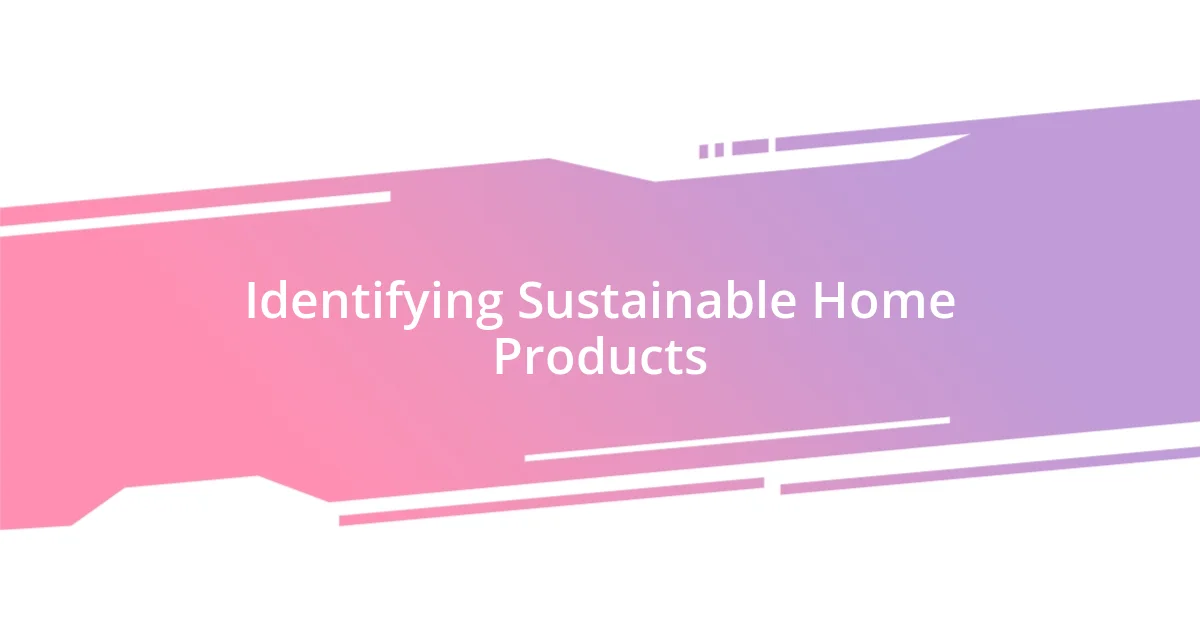Key takeaways:
- Small eco-friendly changes, like using reusable bags and energy-efficient appliances, can lead to a significant positive impact on the environment and personal empowerment.
- Researching sustainable products and understanding their lifecycle, such as opting for biodegradable cleaning supplies and FSC-certified furniture, enhances informed decision-making for a healthier planet.
- Involving family in sustainability efforts and engaging with community groups fosters long-term commitment to eco-friendly practices and collective motivation.

Understanding Eco-Friendly Living Choices
Eco-friendly living choices are more than just trends; they represent a shift in how we interact with our environment. I remember the first time I consciously made a decision to reduce my waste. It was a simple act—bringing my reusable bags to the grocery store—but it sparked a feeling of empowerment. Have you ever felt that rush of taking control of your choices?
Every small change we make adds up, creating a ripple effect in our lives and the community around us. For instance, switching to energy-efficient appliances not only lowers your utility bills but also minimizes your carbon footprint. When I made the switch, I found myself more mindful of my energy consumption, leading to other eco-friendly habits, like unplugging devices when not in use. Isn’t it fascinating how one decision can lead to more?
Understanding eco-friendly living means recognizing the connection between our daily choices and their impact on the planet. I often think about the story of my friend’s journey into composting. Initially, she was unsure, but as she learned about organic waste breakdown and soil enrichment, it became a rewarding part of her routine. Don’t you think about how every little act contributes to a larger purpose?

Identifying Sustainable Home Products
Identifying sustainable home products can seem daunting at first, but I’ve found that a little research goes a long way. When I was looking for cleaning supplies, I stumbled upon eco-friendly brands that use biodegradable ingredients. It felt like I wasn’t just buying a product; I was supporting a healthier planet with every purchase. Have you ever paused to consider what’s truly in the products you use daily?
Another useful tip is to prioritize certifications. For example, when choosing furniture, I look for those labeled as sustainably sourced or certified by organizations like the Forest Stewardship Council (FSC). This simple label gives me peace of mind knowing that my choices support responsible forestry practices. Reflecting on my own experience, I remember the thrill of sourcing a beautifully crafted chair that was not just stylish but also made from reclaimed wood. Isn’t it lovely to think your decor choices can also have a positive story behind them?
Lastly, I’ve discovered that understanding the lifecycle of a product can influence my decisions significantly. From production to disposal, considering how a product affects the environment helps me make informed choices. For instance, I recently switched to bamboo toothbrushes. I thought about how they break down more easily compared to plastic, and that made the choice feel even more rewarding. Isn’t it empowering to know our choices matter, even in the little things we often overlook?
| Product Type | Sustainable Option |
|---|---|
| Cleaning Supplies | Biodegradable Ingredients |
| Furniture | FSC Certified |
| Toothbrushes | Bamboo Material |

Evaluating Energy Efficient Appliances
Evaluating energy-efficient appliances is a step I found both exciting and transformative. When I finally upgraded to an Energy Star-rated washing machine, the difference was remarkable—not just in energy savings but in overall performance. I recall the sense of pride I felt every time I did laundry, knowing I was making a positive choice for the environment. What appliances have you considered that could enhance your eco-friendly home?
As you assess energy-efficient appliances, keep the following tips in mind:
- Energy Ratings: Look for Energy Star or similar labels that indicate efficiency levels.
- Cost vs. Savings: Factor in both the purchase price and potential savings on utility bills over time.
- Size Matters: Choose appliances that fit your needs; larger models might consume more energy.
- Reviews and Comparisons: Research products and read user reviews to gauge real-life performance.
- Rebate Programs: Check for local or national rebates that can offset initial costs.
I still remember the day I unwrapped my new refrigerator. It was larger and sleeker than my old one, yet it consumed a fraction of the energy. That moment made me reflect on how our choices can lead to both financial and environmental benefits. It was like welcoming a new friend into my home, one that would help me embrace a greener lifestyle. Have you found joy in making choices that reduce your environmental impact?

Incorporating Green Landscaping Techniques
Incorporating green landscaping techniques is something I’ve grown passionate about over time. I distinctly remember the moment I replaced my traditional lawn with native plants. Not only did it reduce water usage drastically, but watching butterflies and bees thrive in my garden made me feel like I was positively contributing to local biodiversity. Have you ever considered how your yard could be a haven for wildlife?
One technique I found incredibly rewarding was creating a rain garden. I channeled runoff from my roof to a designated area filled with water-tolerant plants. The first time it rained, I stood by the window, feeling a surge of satisfaction as I watched water pooling in what was once an ordinary patch of grass. It was like witnessing nature’s balance in action. Plus, it saved me from having to deal with muddy spots in my yard!
I also embraced the idea of composting kitchen scraps as part of my landscaping efforts. It may seem small, but turning food waste into rich soil has transformed not only my garden but also my perception of waste. The first time I added that homemade compost to my flower beds, the vibrant blooms that followed brought an unexpected joy; it felt like nurturing life from what would have otherwise been discarded. Have you thought about how composting could enhance your garden’s sustainability?

Utilizing Eco-Friendly Cleaning Methods
Utilizing eco-friendly cleaning methods has been a game-changer in my home. I remember my first experience with homemade cleaning solutions; it was surprisingly simple. Mixing vinegar and baking soda created this bubbling concoction that worked wonders on my kitchen surfaces. The excitement of using something completely natural—and knowing it wasn’t contributing to harmful chemicals in the environment—was an incredible feeling. Have you thought about trying these kinds of natural cleaners in your own home?
There’s something calming about the scents of essential oils wafting through my space while I clean. I started adding a few drops of lemon or lavender oil to my homemade cleaners, turning chores into a sensory experience. It transformed mundane tasks like scrubbing the bathroom into moments of blissful aromatherapy. When I catch a whiff of that fresh lemon scent, it reminds me of my commitment to a healthier home. Have you explored how scents can enhance your cleaning routine?
I also made a habit of using reusable materials, like old cloths instead of paper towels. This decision not only cut down on waste but also saved me money over time. I vividly recall the first time I reached for a soft, reusable cloth instead of the familiar roll of paper towels. The cloth felt right in my hands, and it sparked joy knowing I was making a sustainable choice. Have you considered how small changes in your cleaning routine could contribute to a more eco-friendly lifestyle?

Adopting Zero Waste Practices
Adopting zero waste practices has profoundly changed how I view everyday items. I remember feeling a mixture of excitement and nervousness when I first committed to using glass containers for food storage instead of plastic. When I stacked those jars neatly in my fridge, it sparked a sense of pride—seeing my meals beautifully organized and knowing I was reducing single-use plastic felt gratifying. Have you tried eliminating plastic in your own kitchen yet?
One of my favorite zero waste practices is creating a DIY beauty routine. Initially, I was skeptical about ditching commercial products, but I began making my own face scrubs using simple ingredients like coffee grounds and coconut oil. The first time I applied it, I was pleasantly surprised by not just the fresh scent but also how my skin glowed afterward. I can’t help but wonder, have you ever considered how much you could save by crafting your beauty essentials from items already in your pantry?
Another aspect I embraced is bringing my own bags to the grocery store. It felt a bit awkward at first—going against the usual routine of accepting plastic bags without a second thought. However, I found joy in choosing which bag best matched my outfit, turning a chore into a fun pastime. Plus, every time I left the store, I felt lighter, knowing I had made a small but meaningful step towards reducing waste. Have you thought about how easy it can be to incorporate your own reusable bags into your shopping habits?

Maintaining Long-Term Sustainability Efforts
Maintaining long-term sustainability efforts is all about creating habits that stick. One of my most memorable moments was when I decided to create a chore chart for my family, focusing on eco-friendly tasks. We’d gather around the kitchen table, all excited to see who could come up with the most sustainable idea for the week. It made a significant difference; not only did it hold us accountable, but it turned our efforts into a fun family project. Have you tried involving your loved ones in your sustainability journey?
Another effective strategy I adopted is to regularly re-evaluate my energy consumption. I remember the first time I tracked our energy bills—each month became a mini-challenge to see if we could use less. I started switching off lights and unplugging devices, and over time, I developed a keen awareness of our usage. It felt empowering to see the numbers drop! Have you considered how mindful energy consumption can impact your long-term sustainability?
Staying engaged with sustainability groups has also been a crucial aspect of my journey. I’ll never forget the community event where we exchanged homemade goods and shared tips. It was inspiring to connect with others who are just as passionate about eco-friendly living. These interactions fueled my motivation, reminding me that I’m part of a larger movement. Are you connected to any communities that share your sustainability goals?














